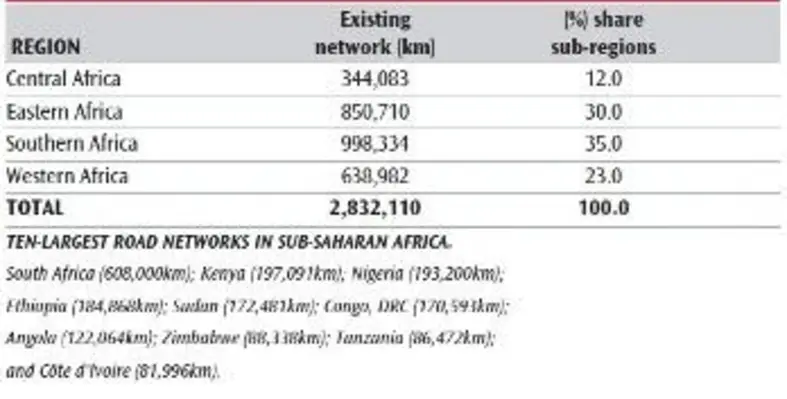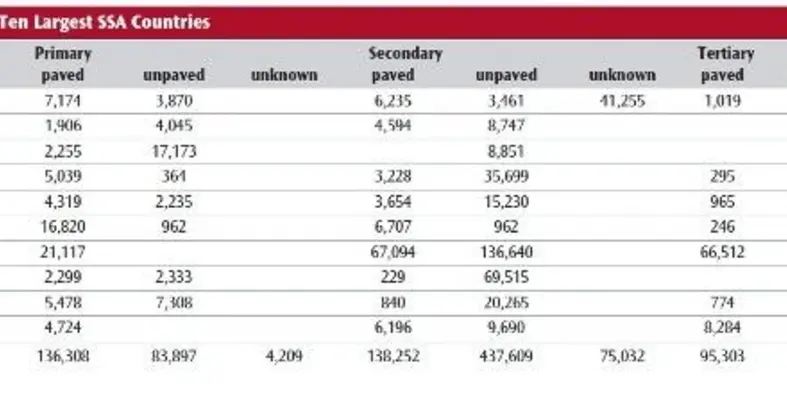Road transport continues to play a critical role in realising Africa’s full potential. Economic correspondent Moin Siddiqi reports
Efficient transport networks enable access to goods, services and opportunities. Globally, countries invest in total between US$1.4-2.1tn annually in transport infrastructure to meet the demand for mobility and connectivity. The World Bank reported, “Africa’s development is highly dependent on an adequate, reliable road system. Good-quality road connections can greatly expand access to jobs, markets, schools and hospitals. For rural communities, a road is often an essential lifeline that links isolated villages to economic opportunities.”
“The problem of Africa can be summed up in one word: transport”, remarked Sir Frederick Lugard, the first colonial governorgeneral of Nigeria, a century ago. Ironically, transportation chain (rural and urban) is still a constraint on rather than a facilitator of economic growth in sub-Saharan Africa (SSA). Road transport remains the principal mode of motorised transport, accounting for over four-fifths of freight and passenger traffic in SSA – hence reflecting low availability of railway lines within the continent (excepting South Africa).
Road density in cities is reportedly low; the road-to population ratio for all of Africa is estimated at 26-km per 10,000 people. The bulk of road surfaces have depleted over decades, reflecting a lack of maintenance and upgrades, with only a quarter of all current roads, totalling more than 2.8mn km across the vast continent that is paved. Other problems are traffic congestion and accidents. According to the UN Economic Commission for Africa (UNECA), the highest number of road fatalities per capita is reported in SSA – estimated at 225,000 people yearly.
Travel times spent travelling across urban areas are also considerable. Africa’s difficult geography presents a logistic challenge for road construction. Existing intraregional road networks are characterised by major discontinuities. Hence, SSA countries (excepting South Africa) score badly on the Global Logistics Performance Index due to poor road connectivity within sub-regions coupled with underdevelopment of systems and trade facilitation procedures. Not surprisingly, Africa also has the globe’s highest transport costs – making regional products uncompetitive on external markets. Internal transportation raises the total cost of African exports by one-third compared to below one-tenth for all developing economies, according to the UNECA. Concurrently, building new roads and increasing the share of paved roads would reduce transport costs, whilst expanding new markets within sub-regions and outside world.
Unexpected shocks
SSA’s current roads are particularly vulnerable to extreme climatic events such as higher temperatures, increased precipitation and flooding – thus resulting in heavy connectivity losses as goods and people are prevented from moving freely. These disruptions affect supply chains, economic output and access to vital services. Rainfall varies across the continent, but even moderate climatic changes in some countries (notably Angola, Cameroon, Mozambique, Nigeria and Sudan) can start large-scale precipitation-related disruptions. Analysts estimated that transport disruptions in Mozambique (due to extreme weather) could cost the economy a whopping US$2.5bn/year over the 2010-50 period.
Only a few countries could cope with projected changes across SSA in annual temperature and frequent flooding. Soaring hot seasons can lead to the softening and rutting of asphalt roads. While for pavedgravel roads, more intense precipitation (which increases flooding frequencies) leads to reduced load-carrying capacity and road erosion, especially on unpaved roads.
Future climate change is a key issue for Africa. “Africa’s major cities and the strategic regional road transport corridors are located along Africa’s coastline, where floods are predicted to be more frequent and severe. Each of the affected countries and cities need to develop strategies and action plans for coping with this danger,” advised Dr. George Banjo, World Bank’s senior transport specialist.
Resilient investments
Transport is crucial to economic development, thus, better road asset management, including construction, maintenance, repairs and more frequent rehabilitation should help prolong road life cycle. Efficient logistics systems are needed across SSA to make new and many existing paved roads more resilient to climate stressors (i.e. extreme temperatures/flooding), whilst upgrading maintenance standards to prevent rapid ageing of welltravelled roads.
The World Bank report, Enhancing the Climate Resilience of Africa’s Infrastructure: The Roads and Bridges Sector, suggested various remedies to increase network connectivity in SSA – the home to 1 billion people. These include both engineering and nonengineering solutions, plus adopting a low-carbon urban transport system such as building walking and cycling lanes. Increasing the drainage capacity of roadways, better shielding of road networks to enable water to the sides, strengthening river banks to prevent regular flooding and using road binders specifically adapted to extreme climates.
A road binder is a heavy-duty long-term road dust suppressant and stabiliser, one treatment controls road dust for three-six months; after treatment no further watering is required. Climate resilient roads have higher construction costs, but lower annual spending on repairs offsets high up-front costs. Other measures include climate risk screening of all major roadbuilding projects, spatial planning to avoid vulnerable flooding areas, improve design standards, as well as innovation in materials and construction methods. Building new pathways, for example, multiple ways to reach the same place can reduce heavy congestion on existing roads and make them safer.
The World Bank also advised SSA countries to adopt non-engineering solutions. These include effective traffic control, like restricting trucking on certain roads, re-routing heavy freight and passenger traffic, and regularly clearing drains/tunnels. Furthermore, Africa needs to reduce exceptionally high greenhouse gas (GHG) emissions produced by cars through price hikes for fossil fuels. Besides building road networks, ‘soft’ infrastructure – professional management of road systems, good contracting, periodic maintenance and inspection are equally critical in providing a reliable transportation service.
Heavy funding
Most countries are making progress to tackle low density and the decrepit state of existing roadways by spending about two per cent of GDP on road rehabilitation projects. Maintenance has improved in some places and regional governments have established active road funds.
However, more capital investments are required since only one-third of rural dwellers live within two kilometres of an all-weather road – based on World Bank’s Rural Access Indicator – the lowest accessibility in developing regions. Broken footbridges and perilous terrain exacerbate ongoing problems. There are estimated 330,000 bridges across SSA. Africa Infrastructure Country Diagnostic study (World Bank) estimated the scale of investment into road sector at US$5.98bn/year in capital spending, plus US$3.65bn/year in operations and maintenance costs.
Johannesburg and Lagos pioneered Bus Rapid Transit (BRT) lines in Africa. These high-speed transport systems with elevated stations and separated lanes are popular in other cities, including Dar es Salaam, where Phase-1 line (covering 20.3 km of truck routes) was opened in 2016 carrying more than 250,000 passengers daily. The Dar es Salaam BRT is planned as a large-scale system of 137 km of high-frequency corridors constructed in six sequential stages.
Phase-2 is underway and Phases [3-4] are due to start construction by mid-2017. The project is financed by multilateral organisations, the Africa Growing Together Fund and Tanzanian government. “The BRT is another great example of how strategic government investments can lead to private sector investments and great outcomes for the people,” World Bank’s President Yong Kim said.
Way forward
Road transport has a critical role to play in realising Africa’s full potential and contributing to ‘food security’ by linking farmers to market centres. Increased urbanisation demands better infrastructure for the movement of people and goods. SSA’s transport sector provides challenges and opportunities for local/ foreign firms to partner with national authorities in building networks of paved roadsas a catalyst for economic advancement and regional integration.
Building strong highwaysbetween inland areas and coastal towns will increase exports and trans-boundary corridors can boost intra-African trade. As the World Bank concluded, “The focus of transport’s role needs to be on increased action to reduce transaction costs and facilitate trade flows and better oriented towards enhancing human and social capital. Roads are a key asset for Africa.” The continent will see substantial road-building works in coming decades.
First appeared in African Review in June 2017.









